Public Pier — No Fishing License Required
What’s with these travel writers anyway? Santa Barbara seems to get more than its fair share of articles in newspapers and travel magazines and I guess that’s natural for a city that officially calls itself “America’s Riviera.” Still, I’ve rarely seen such rich and diverse stories about California’s other seaside villages. One writer wrote about the “faux funk look” of the town and remarked, “The stud through Santa Barbara’s navel is clearly a clip-on.” Turns out that the writer was giving a compliment: the town “is just a little too clean cut to be funky and a little too big to be considered a trendy enclave.” Another waxed poetic—“It was a day when the sky of rich cerulean blue was quietly melting into a clear aqua sea, when the silhouettes of Santa Rosa, Santa Cruz and San Miguel islands arched like great leaping dolphins on the shimmering horizons.”
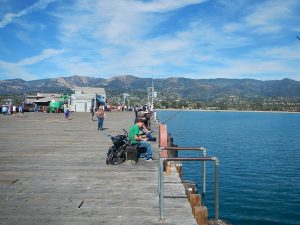
It’s all academic to me. Ask me the color of an urarovite or a chrysocolla and I’ll probably begin a slow drool—perhaps combined with a slightly ticking eyeball. But ask me where to fish in Santa Barbara and I’ll immediately mention Stearns Wharf, the wharf built in 1872 by local lumber merchant John Peck Stearns. It is one of the last of California’s original large working wharves, essential facilities that served not only as ports but also as focal points for entire towns.
Later, with the advent of railroads and automobiles, the wharves became less important. Eventually, pleasure piers replaced some of the old wharves, and still later, most pleasure piers became fishing piers.
Only a few of these big old wharves remain: Redondo Beach, Monterey, Santa Cruz and Santa Barbara. Today each is a large multi-use facility that caters to a wide range of interests. Stearns is the home of fine restaurants, fresh fish markets, ecology groups, a museum/aquarium (the Ty Warner Sea Center), Gypsy palmistry, and an estimated five million visitors a year. Fishermen and fishing don’t always get the most attention, but they still provide a lot of the life, flavor and excitement on the pier.
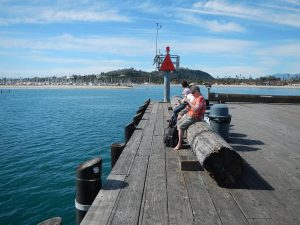
The wharf: Battered but unbowed
The following article, written two decades ago, expresses concern for the wharf but it’s still there and (I think) as good as ever. The main change, and it’s a big one to this old pier rat, is the installation of railings out at the end that occurred just before July 4, 2018. Growing up I fished from Newport Pier and there were no railings (and only a few people fell off). It was the same at Sterns. But apparently fear of injury and lawsuit took its toll. Now everyone can feel just a little more safe.
Off The Beat
I stood on the far end of Stearns Wharf and wondered how long it could stand the pounding. With powerful, chocolate brown-colored waves battering the 126-year-old pier, and around 150 thick planks already knocked out, could it survive? Survive? A few hours later, the Harbor Restaurant was hosting 300 guests…”A fast recovery,” laughed hostess Janet Johnson. Despite needing an estimated $250,000 in repairs, the wharf was open to the public Wednesday, except where replacement of pilings and planks was under way at the ocean end. “The wharf is looking great and businesses are open,” Al Steinman, owner of Moby Dick’s Restaurant said Wednesday. “The city’s really on the ball.”…
But Tuesday afternoon, I didn’t see how John Peck Stearns’ 1872 pier could last another day. Steinman was checking his place. “I got down here about 5 a.m. It was wild. I’ve never seen it that wild. Forty to 50 mile-an-hour winds, at least. The blowing sand peppered you. But all the people showed up for work this morning. The faithful. “Its déjà vu all over again,” he said, recalling the 1983 storm that knocked the restaurant out of business for months.
But despite wave after giant wave battering the pilings and crashing under the Harbor Restaurant Tuesday, I found no one who had the slightest doubt that the wharf would survive the pounding. Picking my way past gaping holes in the planking with News-Press photographer Steve Malone, I met yellow-slickered Dwayne Johnson, a city wharf worker at the far end. “It’s pretty dangerous out here,” Johnson warned as a cold wind and rain lashed us. The Coast Guard shack, holding the foghorn, had been swept overboard the night before. Splintered 4-by-12 planks were piled like broken matches. “Even the wishing well was wrecked,” Johnson said, pointing to railings around the open area where tourists peer into the depths at the sea life and toss money down…
I thought of the story I wrote after the February 1983 storm, about how the old pier had survived countless acts of man and God. It was only six years old when a south-easter tore out 1,000 feet. In 1887 the cadence of 200 marching Civil war vets set the rickety pier swaying so much that 3,000 onlookers were nearly pitched in the drink… In 1921 the wharf was set afire by sparks from a hotel blaze. In 1925 a storm carried the Yacht Club clubhouse out to sea… But by Wednesday’s early light, the pier was still there, the huge American flag still flying.
—Barney Brantingham, Off The Beat, Santa Barbara News-Press, February 5, 1998
Environment. Although Stearns is basically an oceanfront, sandy-shore pier, Santa Barbara’s artificial harbor and its breakwater sit just a short distance west of the pier. In effect, some currents and wave actions are blocked although it’s hard to gauge the overall impact to the fishing. However, the necessary yearly dredging of the harbor’s entrance (usually in the winter) can affect the clarity of the water and the turbidity can affect the fishing during the time of dredging.
Unfortunately the pilings, once heavily encrusted with mussels, have suffered the same consequence as many other southern California piers. They’ve been wrapped with rubber and rarely show the same growth on them as unwrapped pilings; lack of pile organisms like mussels, and the various other assorted critters that inhabit the mussel environment, also means less fish cruisin’ around the pilings. Nevertheless, there can be decent amounts of kelp by the pilings some years and fish will be attracted to the kelp and its associated creatures.
Also unfortunate is the amount of the pier actually open to angling. The listed length is 1,950 feet, the width 40-150 feet, and the distance from water to deck 15 feet When I first fished the pier back in the early ‘80s almost the entire pier was open to fishing, at least those parts that weren’t covered by commercial establishments. Today the narrow inshore section prohibits fishing; it has something to do with the possibility of a stray sinker plunging through a car’s windshield (it makes sense). Mid-pier areas are heavily covered with businesses and/or reserved parking spaces for cars and again there’s a reluctance to allow hook and sinker people, and their occasional careless casting, into those areas (it makes sense). Although I’m told some fishing is still allowed in front of the Sea Center, the majority of fishing area is the far end of the pier, roughly 300 feet of wide-open space. And I do mean wide-open space since there are no railings (although a few benches and really big eucalyptus logs).
With the loss of the inshore and mid-pier areas to fishing comes a loss of two normal SoCal pier activities: (1) fishing the surf area for barred surfperch and (2) fishing just out from the surf area for halibut. Although the former may not be a big loss, since the moderate waves do not provide as good fishing as piers with more sand disturbing wave action, the mid-pier halibut loss is significant. Kayakers and tubers report good halibut action near the pier in areas and water depths no longer available to most of the pier anglers. Halibut are still available out at the end but I’m convinced far more would be taken if the mid-pier section were open for fishing.
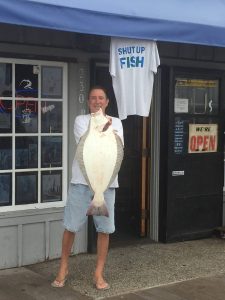
A keeper-size California halibut
Fish available at the pier are the normal southern California species with halibut, mackerel, jacksmelt, white croaker (ronkie), sand bass, kelp bass (calico bass), scorpionfish (sculpin), various perch, bat rays, and shovelnose guitarfish (sand sharks) dominating the catch. A good attribute, since most of these species are small, is the moderate wave action and the fact that the pier’s surface is fairly close to the water; most of the time an angler can fish with a fairly light line and weight.
And even though many of the pier’s anglers will rarely see it (due to the techniques they chose to follow), there can be good variety. As example, a three-hour trip by myself on a mid-June evening in ’95 produced ten different species of fish. Included were several types of perch, two types of croaker, sand bass, Pacific mackerel, jack mackerel, sanddabs and even a scorpionfish. The scorpionfish was the strangest of the night. I had caught a small queenfish and decided to use it for live bait. A few minutes later I had a strike and pulled in a scorpionfish that was barely bigger than the queenfish. What the spiny beast was doing attacking the queenfish was unclear since the queenfish would not have fit down El Scorpio’s gullet.
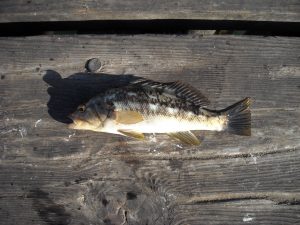
A small kelp bass aka as calico bass
One species of note is kelp bass; of the 35 southern California piers in my personal record book, only the two piers at Catalina show a higher number of kelp bass than Stearns. I’m not sure why the number is so high but there’s a lot of the feisty little bass under the wharf. Unfortunately most are 8-10 inches long and thus illegal to keep.
One interesting local enigma is the unusual name used for white croaker. Generally in southern California a white croaker is called a tomcod (not to be confused with the true tomcod of northern waters). In central California and the San Francisco Bay region the fish is called a kingfish (not to confused with the kingfish of the southern and Gulf states). But no, Santa Barbara has to be different; in this area the fish has traditionally gone by the alias “Roncador” or “Ronkie.” Although the latter sounds like something out of Star Wars, many Santa Barbarans (Barbarians? —just kidding) continue to use the name. To be fair, many people in southern California used to call the little croaker a Pasadena trout and no doubt it was a put down on both the fish and on Pasadena. I doubt if anyone would be offended by calling it a “Ronkie.”
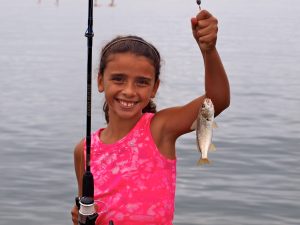
She’s got a white croaker that’s locally called a roncador (the snorer)
The non-fishing environment, as mentioned, is also interesting with its eclectic mix of restaurants, shops and tourists from throughout the world seeking out a bit of (somewhat unnatural) nature. On shore, the waterfront is lined with towering palms, buildings with attractive early California architecture, and a backdrop view of the Santa Ynez Mountains that can be hard to beat on a clear day. It’s a beautiful area with an interesting aura to it, just wish it wasn’t so crowded—and pricey.
Fish and Fishing Tips. With the restrictions on fishing space, most fishing is at the end and most of the recommendations apply to that area. Three main types of fishing are practiced. Both the regulars and the tourists use the first. Bait rigs, mainly Sabiki but also Lucky Lura and others, are used in the pursuit of baitfish (by regulars) and any and all fish by others. Several species of baitfish come in near the wharf with Pacific mackerel, Spanish mackerel (jack mackerel), and sardines leading the hit parade. When they’re present they are usually present in good numbers. Smelt, both jacksmelt and topsmelt, will also be taken on the bait rigs, as will walleye surfperch, shinerperch and occasionally queenfish.
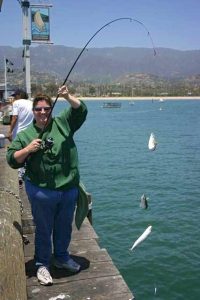
How about some mackerel?
The second main technique, primarily used by regulars, is to take the live baitfish that was caught by the bait rigs and fish on the bottom for halibut, sharks or rays. Generally a Carolina-type rig, aka fish-finder-rig, is used in which the line is free to move through an egg sinker. All of the baitfish mentioned make good halibut bait (and I especially like small queenfish), while sharks prefer something a little oilier and smellier; they especially like mini-mackerel.
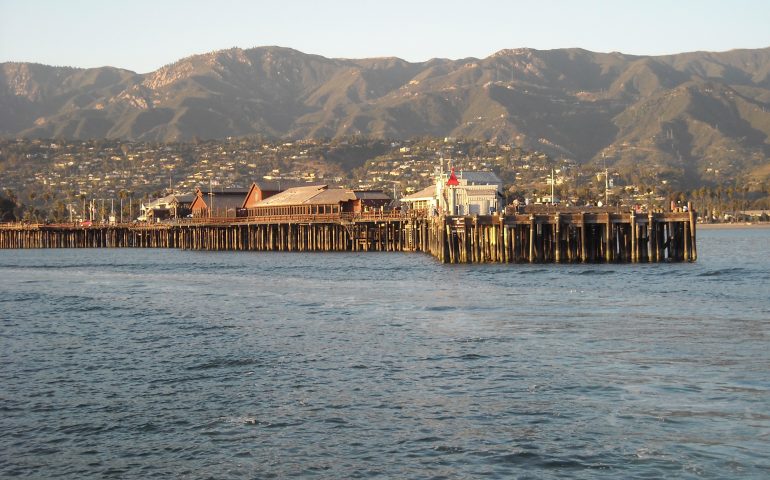
Awesome write up! Thanks. We just caught a 36 inch halibut off the pier, 6/25/19. Email me for pics
I used to fish Stearns Wharf all the time when I was a kid back in the late 80s / early 90s. I remember it was usually always really good for mackerel, with bonito and barracuda showing up usually in Sept. and Oct. There were also times when truly monster size halibut would show up and hang around the pier for weeks at a time. Other than that the fishing there for other species wasn’t all that great, and the surf area was pretty lifeless, no doubt due to the little 6 inch waves, just an occasional thornback and a corbina might cruise by every once in a while.
Is it true that fish off Stearn’s Wharf should not be eaten because the waters around there is not polluted?
Thanks.
No, some fish should be eaten less often than others and there are better and worse ways to cook them (as discussed in the book) but a general answer is no.